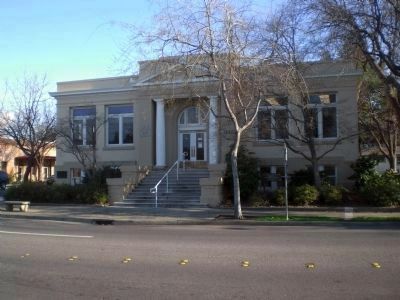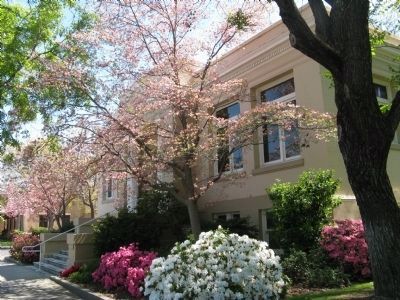Oroville in Butte County, California — The American West (Pacific Coastal)
Oroville Carnegie Library
Built 1912
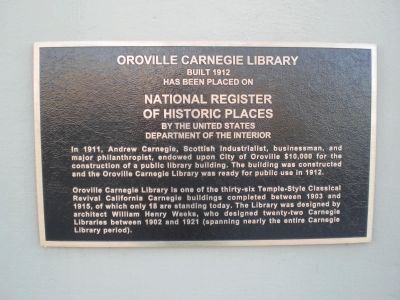
Photographed By Andrew Ruppenstein, March 6, 2009
1. Oroville Carnegie Library Marker
Nation Register of Historic Places Registration Form:
Click for more information.
Click for more information.
Oroville Carnegie Library, built 1912, has been placed on the National Register of Historic Places by the United States Department of the Interior.
In 1911, Andrew Carnegie, Scottish industrialist, businessman, and major philanthropist, endowed upon City of Oroville $10,000 for the construction of a public library building. The building was constructed and the Oroville Public Library was ready for public use in 1912.
Oroville Public Library is one of the thirty-six Temple-Style Classical Revival California Carnegie buildings completed between 1903 and 1918, of which only 18 are standing today. The library was designed by architect William Henry Weeks, who designed twenty-two libraries between 1902 and 1921 (spanning nearly the entire Carnegie Library period).
Topics and series. This historical marker is listed in these topic lists: Arts, Letters, Music • Charity & Public Work • Education. In addition, it is included in the Carnegie Libraries series list. A significant historical year for this entry is 1911.
Location. 39° 30.769′ N, 121° 33.532′ W. Marker is in Oroville, California, in Butte County. Marker is at the intersection of Montgomery Street and Oak Street, on the right when traveling east on Montgomery Street. Touch for map. Marker is at or near this postal address: 1675 Montgomery Street, Oroville CA 95965, United States of America. Touch for directions.
Other nearby markers. At least 8 other markers are within walking distance of this marker. Oroville Municipal Airport (within shouting distance of this marker); Butte County Court House at Oroville (about 600 feet away, measured in a direct line); Gardella-Reece Building (about 700 feet away); First Liberty Pole In The West (about 800 feet away); Liberty Pole (about 800 feet away); Butte County Courthouse Bricks (about 800 feet away); County Community Well (about 800 feet away); Gray Nurse Hardware (about 800 feet away). Touch for a list and map of all markers in Oroville.
Also see . . . William H. Weeks, Architect Extraordinaire. Bishop Union High School website entry:
Robert G. Lemmon Jr.'s biography of architect William H. Weeks (1866-1936). Includes listing of his works, as well as descriptions and photographs. (Submitted on March 21, 2009.)
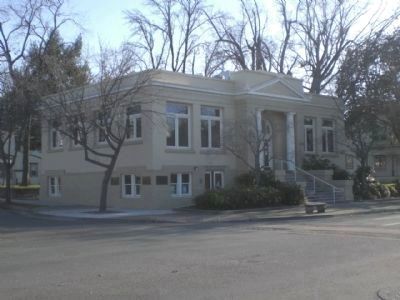
Photographed By Andrew Ruppenstein, March 6, 2009
2. Oroville Carnegie Library and Markers
Oroville's first library dates back to 1859, a "ladies" library. After the city received a $10,000 Carnegie grant in 1911, this Classical Revival-style library was built on a site donated by Senator George Perkins.
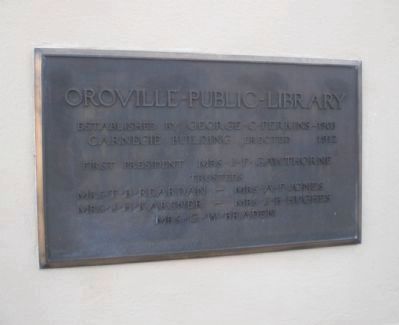
Photographed By Andrew Ruppenstein, March 6, 2009
3. Oroville Carnegie Library Dedication Plaque
{Dedication plaque reads:} Oroville Public Library; Established by George C. Perkins, 1903; Carnegie Building erected 1912; First president Mrs. J. F. Gawthorne; Trustees Mrs. T.B. Reardan, Mrs. A.F. Jones, Mrs. J.H.Karsner, Mrs. J.B. Hughes, Mrs. G. W. Braden
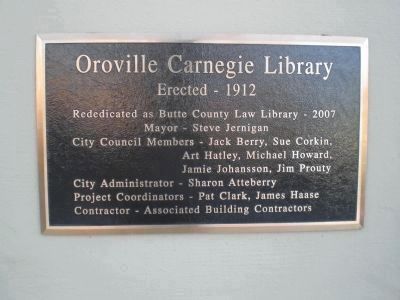
Photographed By Andrew Ruppenstein, March 6, 2009
4. Oroville Carnegie Library Rededication Plaque
{Rededication plaque reads:} Oroville Public Libary, Erected 1912, Rededicated as Butte County Law Library, 2007; Mayor - Steve Jernigan; City Council Members - Jack Berry, Sue Corkin, Art Hatley, Michael Howard, Jamie Johansson, Jim Prouty; City Administrator - Sharon Atteberry; Project Coordinators - Pat Clark, James Haase; Contractor - Associated Building Contractors
Credits. This page was last revised on November 27, 2023. It was originally submitted on March 21, 2009, by Andrew Ruppenstein of Lamorinda, California. This page has been viewed 1,983 times since then and 40 times this year. Photos: 1, 2, 3, 4, 5. submitted on March 21, 2009, by Andrew Ruppenstein of Lamorinda, California. 6. submitted on April 7, 2009. • Kevin W. was the editor who published this page.
